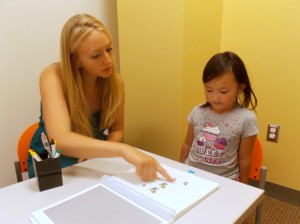Iron deficiency is a leading problem for children who spend significant time in an institution before adoption into U.S. families. Around 25 percent of internationally adopted kids are iron deficient at adoption compared to only five percent of similarly aged children who are raised from birth in U.S. homes.

Over the past five years, the International Adoption Project (IAP) has followed about 200 international adoptees. Jenalee Doom, a doctoral student in the Institute of Child Development, is a member of the team. She has participated in research about iron deficiency and brain development in internationally adopted children in a study associated with the University’s International Adoption Clinic, where about 250 children come each year for intake exams and assessments. Her research is helping to document the impact of early iron deficiency on cognitive development over time.
The study is led by Regents Professor Megan Gunnar in the Institute of Child Development; professor of pediatrics Michael Georgieff, M.D., consults on the iron deficiency work. Doom was excited to present their team’s research at CEHD Research Day this spring.
“I love working with the kids in sessions, but the most exciting part is what it can do for children who are living in orphanages and those who are getting adopted,” says Doom.
The team studied 35 non-adopted children and 88 children adopted internationally at about age five who had spent up to 34 months in an institution such as a hospital or orphanage before arriving in the United States. All the research is conducted with parental consent. The study drew on medical visits, parental reports, observation of cognitive tasks, and other tests to determine whether iron levels had an effect on IQ and attention deficit and hyperactivity disorder (ADHD) symptoms at age five.
The IAP team has met with the children in the study every eight months, examining different aspects of children’s development. During the visits, parents are asked about their child’s ability to self regulate—whether the child is compulsive, hyperactive, or having trouble paying attention. Researchers also report on the ADHD symptoms they observe. The combined reports created an ADHD measure that Doom could use to decipher the presence and severity of ADHD symptoms. She helped to conduct research sessions with children alongside IAP team members and then analyzed the data collected. The researchers are not aware of the children’s iron status when assessing their development variables.
Findings
In general, the team found that children with more severe iron deficiency at adoption had lower IQs and more ADHD symptoms at age five. Because iron deficiency affects children’s ability to pay attention and self-regulate, they may score lower on cognitive tests as a result. Also, the longer children had spent in an institution before adoption, the more ADHD symptoms they had at age five. Finally, children who had been in an institution for more than 12 months or who had more severe iron deficiency at adoption showed a substantial rebound in IQ by age five.
“That is a tremendous accomplishment and demonstrates those children’s ability to recover from early stress and adapt to their new families,” says Doom. “We are finding that the internationally adopted children are remarkably resilient and often show improvement in a number of areas over time.”
Doom became involved with the International Adoption Project in 2011. As a graduate student in the Institute of Child Development, she wanted to study how early adversity affects long-term physical and mental health. She was interested in nutrition and joined the study with her advisers, Gunnar and Georgieff, who also direct the U’s Center for Neurobehavioral Development.
Of course, iron deficiency is not specific to adoption. Because the study documents the importance of iron through its effect on brain development and behavior regulation, adoption agencies, institutions, expectant moms, and new parents can all benefit from the study.
The iron deficiency study was one of 50 projects featured at CEHD’s annual Research Day. See this and the other posters.
Story by Ali Lacey | Photo by Bao Moua | Fall 2014